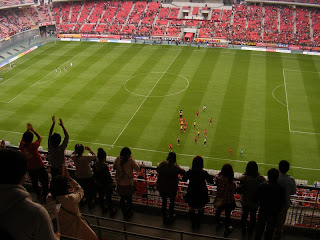A village on the north bank of the Tees before 1914 Billingham was built on war, water and bombs, its proximity to the river, Durham coalfields and an
offshoot of the Stockton and Darlington Railway making it a perfect base for
the new Government Nitrogen Factory. The plant’s armaments production led to
growth which was explosive in both senses of the word: within two decades there
was a town of 19,000 people, a chemical works which employed more than a
quarter of the local population, and the world’s only football team to take its
name from an agricultural fertiliser.
Billingham Synthonia began life on a pitch within the
grounds of Imperial Chemical Industries. Joining the Northern League at the end
of World War II, the club took part in the first floodlit game of football to
be played in north-east England – 3,000 fans watching them beat an RAF side by
eight goals to four in November 1952 – and briefly had a forward by the name of
Brian Howard Clough in their side until he left his job as an ICI office junior
to do national service and don the red shirt of Middlesbrough FC. One of three Northern League grounds within a
five-minute drive of the point where the A19 and A1027 overlap, the Central
Avenue Stadium’s 2,000-capacity cantilevered stand was the longest anywhere in
the country when it opened in September 1958 with a game against FA Amateur Cup
holders Bishop Auckland.
The few hundred fans, wrapped up in new hats and jackets, take
refuge from the buffeting winds under the stand’s metal roof as a blast of U2
accompanies Billingham’s two teams across the cinder running track. “We are the
Synners haters,” chorus a group of six Town fans in blue and white, earning wry
smiles from those in green. Across the pitch, you can see the slim floodlights
of Town’s Bedford Terrace stadium through the bare, wintry branches. The Belsais Lane pitch
which Clough turned out on is now an abandoned office block, marked out for
demolition a couple of hundred metres from the Central Avenue’s turnstile.
It’s a scrappy, impatient first quarter, low on quality
until Synthonia’s Matty Crossen turns smartly past a defender on the left
touchline and delivers a cross which Danny Earl stops with one foot and stabs
past Town keeper James Briggs with the other. “The scorer for Synthonia is
Danny Earl,” crackles a voice from the tannoy. Half the stand is still
chattering excitedly when Glenn Butterworth tries his luck from midway between
the Synthonia goal and halfway line, the ball dipping over the flailing right
hand of ex-Town keeper Josh Moody. “Goal
for Billingham Town in the 24th minute,”
says the announcer grudgingly, not bothering to supply the goalscorer’s name. With
the wind at their backs, the visitors aim high balls over the Synthonia defence
for the diminutive Nicky Martin and recent signing Dave Onions to hurtle
after. “Look at that, they defend with ten and leave one up top,” a home fan
says, the disgust seeping from every syllable. “We don’t do that.” On the stroke of half time, Earl splits the
centre backs with a ball that Crossen thuds against the base of the post. “Just
a matter of time,” slurps a home fan through his Bovril.
Wind assisted in the second half, there’s a sense of
inevitability about a second goal for Synthonia. Despite the occasional danger posed by the pace of Onions, gusts of wind more often curl attempted clearances back on Town’s hard
pressed defence. When the goal does come, though, it’s an anti-climax - a cross headed
down by ex-Town defender Danny Wray and the ball just beating Briggs across the line with seventy minutes played.
Already embroiled in a relegation scrap with Tow Law Town and Jarrow Roofing, the blue half
of Billingham push forward desperately. “Get
in to the gits,” someone jokes. “Come on Town,” a woman’s voice urges
repeatedly. But with just a minute of the ninety left to play, and the crowd
spilling down the stairs to the bar and exit gate, midfielder Jamie Blyth beats
Briggs from the edge of the box. 3-1 Synthonia and the smiles are on the faces
of the people wearing green and white.
Date: December 26th 2011
Admission: £5



















































